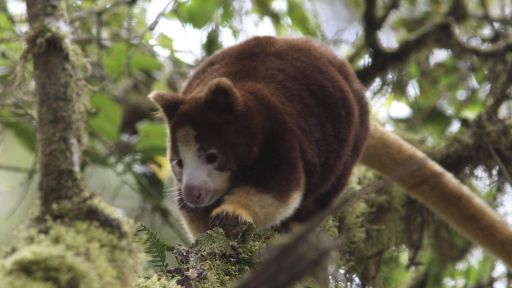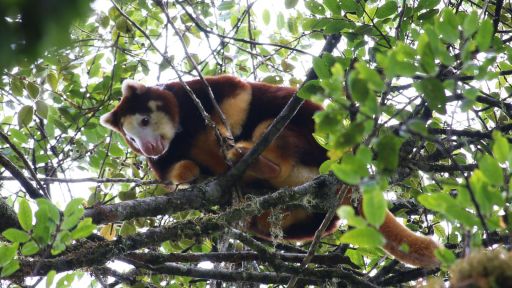Meet the elusive Matschie’s tree kangaroo in the cloud forests of Papua New Guinea and discover how the local people are helping to protect this rare marsupial and its forest home. Follow Lisa Dabek and her team with Woodland Park Zoo’s Tree Kangaroo Conservation Program.
A Life Among the Clouds: A NATURE Short Film
Join Lisa Dabek and her team with Woodland Park Zoo’s Tree Kangaroo Conservation Program as they journey into the remote cloud forests of Papua New Guinea. Meet one of the most elusive creatures you will ever see in the wild – the Matschie’s tree kangaroo. See how the local people are helping to protect this rare marsupial and its forest home.
Features
When you're a kid and you think of a very far-off magical place this is it.
A mysterious island shrouded in fog.
Around the world, cloud forests are rapidly disappearing and this is one of the last intact cloud forests on earth.
The island of New Guinea is unique in all the world. Hundreds of endemic species are found only here and many yet to be discovered.
It's a forest of secrets.
The Matschie's tree kangaroo is an endangered species. Its only home is the northeastern portion of Papua New Guinea.
Doing fieldwork in Papua New Guinea is very challenging because it's so remote and what I'm trying to do is get the world to know about tree kangaroos because they are the flagship species for cloud forests on the island of New Guinea.
Tree kangaroos are elusive and make their homes high up in the dense moss-covered canopy.
You can walk right underneath one and never know it's there.
They are perfectly camouflaged.
And you cannot actually observe their behavior directly which is, as an animal behaviorists, is very frustrating.
But we can figure out different ways... We've used this 'critter-cam' method of having them videotape themselves so we can look at their feeding behavior. We use radio collars to study their home range, so there's a variety of ways to get into the life of a tree kangaroo.
'So it's pretty tough trying to just find them in the wild and, like I say, sometimes it's just totally come off less.
You just really have to see where they are and all that. With the locals we have some good locals that have this eye that they could really spot.'
The best trackers are local hunters who have an intimate understanding of the forests and these animals.
If we can successfully capture a tree kangaroo it will give us a chance to test out a new kind of GPS collar.
Within hours our team has caught its first tree kangaroo.
The tree kangaroo is unharmed and tucked safely away in the bag.
'We have one!'
'We've got a tree kangaroo!'
Once back at camp we check her vitals and give her a mild sedative.
Then we begin collecting as much information about the health genetics and overall physical condition of our new study animal. The biggest surprise is this female has a tiny baby - a very young joey only about a month old and still attached to the teat in the moms pouch.
So for the first three months of life it's attached to the teat. It doesn't come off.
It's like continually suckling. It's like another pregnancy.
And tree kangaroos are adapted for life in the trees. Some of the things that make them special are their long claws which are really good for climbing the trees.
They've got very rough pads on their feet for climbing those trees. Also they have a long tail, but it's not prehensile, it's used for balancing.
It's very exciting for all of us to be able to, you know, really spend time with the animal that you're studying.
'Oh, is she beautiful or what?'
This last step is the reason why we're all here.
We fit our study animal with a new kind of GPS collar and hope everything goes according to plan.
'Alright let's get her back in the bag, so she can rest. Okay.'
With her brand-new GPS collar attached, it is now time to release her back into the wild.
So one of the reasons why I love working in Papua New Guinea and why I've dedicated my life to working here is because the land is owned by the local people.
So I always say it's the tree kangaroo that brought me to Papua New Guinea and it's the people that keep me working here.
And I think what's so important, and I think it's a lesson for the world, is that if you empower local land owners to be stewards of their forests, their seas, their wildlife, they can take care of it and it can be sustainable.
'Okay see you!'
'Bye!'
'Bye!'
Over the course of this expedition we would capture, collar and release five tree kangaroos.
We're using these new collars, these GPS collars, and already in the space of a week we have been able to download some data.
It is incredibly exciting, I mean, I've been waiting for this kind of information for probably 15 years.
We are learning when they are moving up and down the trees so what is their time budget - how do they spend their day, how do they spend their night?
We are already seeing that. The other thing that we're able to do is get so many more GPS points for each animal, which means we are able to see where they spend their time in the forest and we're going to be able to overlay that on a map of the forest. And then we can look at what trees they're spending more of their time in, where they're feeding, etc. So it's very exciting and I know, you know, science is bit by bit, but this particular trip has been very exciting because we're trying new technology and we're also getting a better handle on the animals themselves.
But this is only part of the story.
If you look out over this forest all this land, as far as the eye can see, is owned by the local people. It is now one of the largest protected cloud forests in the world.
The surrounding villages have joined together to protect and care for these forests and the wildlife within, creating the YUS Conservation Area.
So we have supported them in creating a conservation coffee and so there's a new coffee cooperative that's come up in the YUS community and they're very proud to be saying that they are selling YUS conservation coffee.
And what that's allowing the farmers to do is send their kids to school when they sell coffee.
They can get health care for their families and they're also protecting the forests.
They themselves created the first conservation area for Papua New Guinea.
This makes YUS a model community for the whole country and that's something that I'm very very proud of and proud to be a part of.
you
You May Also Like








